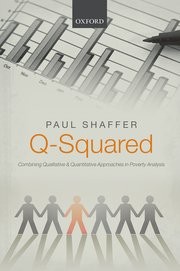Q-Squared
Random control trials and ethnographic studies use very different approaches to answer research questions. Often the underlying epistemological foundations differ, the means of measurement differ, and the process of understanding causation differ. But, does it matter? It one approach more accurate than another? Do qualitative and quantitative studies arrive at similar conclusions? These questions are addressed in "Q-Squared: Combining Qualitative and Quantitative Approaches in Poverty Analysis" (2013) by Paul Shaffer. He writes that "such methodological approaches are not 'good' or 'bad' in themselves, but they do have implications for how we understand and explain poverty, and what we propose to do about it… A core objective of this book is to examine the underlying assumptions and implications of how we conceptualize and investigate poverty" (p. 3).
Shaffer speaks about the progression of understanding, with a 'first generation' of research seeking to answer the question if the different approaches arrive at similar results: "Many of the initial Q2 studies examined if local conceptions and income/consumption poverty identified the same individuals/households, or characteristics of individuals/households, as poor, and/or if they were generating similar findings with respect to poverty levels and trends. The core conclusion of this body of literature was that systematic differences did in fact exist on all counts" (p. 34). In summary: it matters. The results are not the same. In explaining why this the case, Shaffer writes "a major part of the explanation has to do with the different dimensions of poverty highlighted by the two poverty approaches. There are other potential reasons as well, relating to perverse consumption, population coverage, intrahousehold issues, visibility bias, recall, and nostalgia bias" (p. 39).
The 'second generation' of research set out to test if qualitative and quantitative approaches could be combined to improve the way we study poverty, resulting in experimentation and a host of methodologies. "The second generation of Q2 analysis attempted to bridge such differences [those identified in the first generation of study] by incorporating locally meaningful definitions, weights, and thresholds of poverty into the analysis in ways that addressed concerns of interpersonal comparisons and external validity" (p. 57). One area of research I felt under explored, which emerged during this same time period, was a greater recognition of integrating the importance of politics and power – a subject that Shaffer does not address in much detail in his examples.
For those working within the space of mixed methods research, the conclusions of the book are not new. Shaffer summarizes: "Of the many issues raised throughout this book, two central messages stand out. First, foundations matter. Foundational assumptions have implications for the conceptual categories and analytical lens we use. They determine what counts as reliable knowledge and 'hard' evidence, how to ascertain validity, how causation is defined and causal claims established empirically and so forth. Foundations also matter for research results, when, for example, different approaches to poverty come to different conclusions about 'who is poor' or different conceptions of causation arrive at different conclusions about the causal impact of development programmes… The second central message is that mixed method analyses add value" (p. 107).
The book is largely a summary of findings and research trends, and as such would be useful for upper undergraduate or graduate students. There are useful summaries and signposts throughout that make for easy reading and reference. Some aspects of the book may be unsuitable for undergraduate audiences, and instead specific chapters selected for course work reading. An important strength of the book is that I think it is suitable both for an economist interested in anthropological approaches, as well as an anthropologist interested in statistical analyses. Not an easy task, but Shaffer explains the importance and value of different approaches that it could be used in for students of diverse academic backgrounds.

